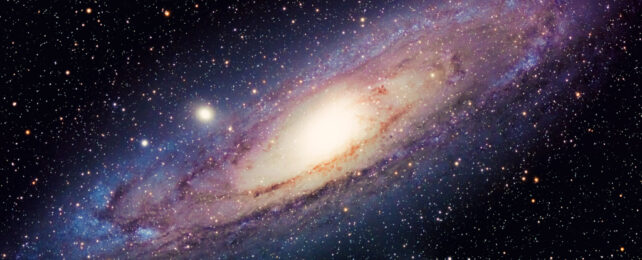Look hard enough at the roiling mist of gas and starlight that is our galaxy, and you'll find traces of a violent upbringing.
Yet the scars of our past aren't always easy to distinguish from more mundane tides that advance cosmic evolution, leaving researchers to speculate which patterns are evidence of cataclysmic events and which are typical signs of aging.
Using data collected using the Gaia satellite, an international team of researchers has uncovered what could be fresh details of a hypothetical dust-up between the Milky Way and an orbiting body of stars.
Since the 1960s, a series of studies have slowly revealed a distinct S-shaped bend can be seen in our galaxy's disk, speculated to be the product of a repeat beef with a smaller neighbor such as the Sagittarius Dwarf Spheroidal Galaxy.
According to a recent analysis, the positions and movements of tens of thousands of stars stretching a quarter of the way across the galaxy suggest the bend may itself be quietly ringing with a wave propagating through the large-scale warp.
Led by astronomer Eloisa Poggio at the Italian National Institute for Astrophysics, the team compared data on some 16,000 young giants and around 3,400 'distance marker' stars called Cepheids, statistically correlating their back-and-forth movements with their up-and-down motion.
The result is an oscillation that looks uncannily like the rolling motion of an ocean's swell coursing through the masses of stars out from the Milky Way's center, on top of but distinct from the tsunami surging below.
While the corrugation barely rises above the plane of the galaxy, its spatial extension is vast, calculated to stretch more than a quarter of the way out towards the edges of the disk, with the outward-moving stars deviating from their paths at around 10 to 15 kilometers (around 6 to 9 miles) a second.
Whether the radial and vertical motions are connected, or whether the corrugation and underlying warp ought to share a common cause is debatable. It was only by removing the signature of the Milky Way's bend itself that the remaining variations in star positions suggested some kind of abnormality may even be present.
"The warp and the wave do not necessarily need to be caused by the same event," Poggio explained to ScienceAlert. "However, we will try to explore this point in the future using numerical simulations."
Our galaxy hides its bruises well. It's only by looking for the subtle signatures of stars sitting out of place or moving in a curious direction that we might find reason at all to search for traces of past grievances.
"Future works analyzing other datasets, as well as different galaxy formation models, will reveal further details on the formation and evolution of the observed feature, as well as a more detailed dynamical description of how waves propagate in the disc of the Milky Way," the researchers conclude in their report.
This research was submitted to Astronomy & Astrophysics and is available on the preprint server arXiv.
